Wickhampton, Norfolk (†Norwich) C.14
The Seven Works of Mercy
Upper tier, from left: Feeding the Hungry, Giving Drink to the Thirsty, Clothing the Naked, Receiving the Stranger
Lower tier, from left: Visiting the Imprisoned, Visiting the Sick, Burying the Dead. Christ Blessing
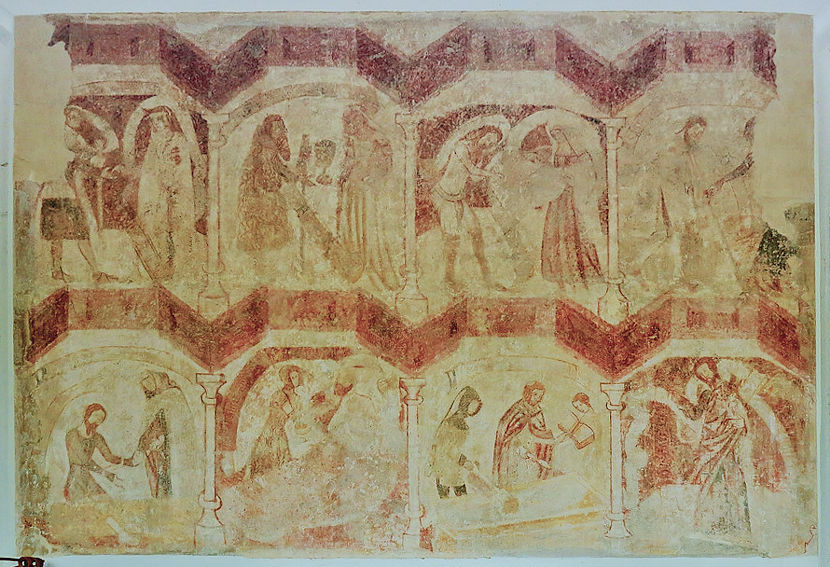
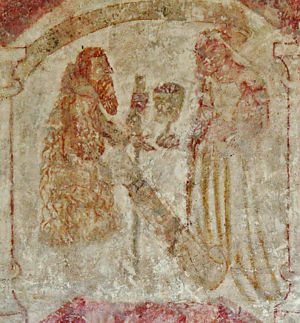
This Seven Works is complete, although some scenes are clearer than others. As at nearby Moulton St Mary, a woman performs the Works, and the general treatment here, including the architectural detail framing the individual scenes, is also reminiscent of the fine painting at Moulton. At the top left is Feeding the Hungry, damaged, but recognisable and including the explanatory speech-scrolls (now illegible) still visible in other scenes.
Next to the right comes Giving Drink to the Thirsty, with a woman standing at the right offering a large cup to a man with a long beard at the left. The man is a pilgrim, and he has a staff on which his hat hangs, as in the painting of St Roch at Pinvin. My previous suggestion that this was actually a man holding a hawk was quite wrong, and relied far too much on the old drawings by Winter, never the most accurate of copyists, hanging in the church. Next comes Clothing the Naked, which unfortunately is not clear enough to show in detail.
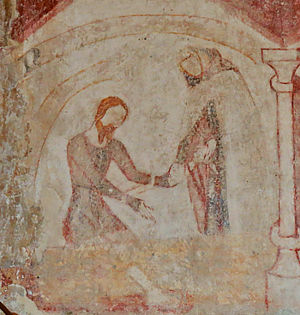
Clearer, (and pictured right) is Visiting the Prisoner, showing a man at the left with a shackle across his wrists and his legs in wooden stocks. His female benefactor wears an outdoor cloak and hands him something, possibly money. with a man wearing a loincloth accepting a garment from a woman at his right. The scene beyond this is the most obscure, but it must be Receiving the Stranger.
Shown out of order at the left below is the final scene in the series, Christ blessing the Works of Mercy (the scene at the lowest right on the wall.
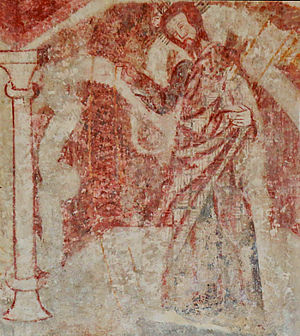
But the inclusion in paintings of this subject of a scene of Christ blessing the Works and those performing them seems, on the surviving evidence, to have been normal practice once and several of the other English examples of the subject in the table below include such a scene. Closest by far in style and general treatment is the painting at nearby Moulton St Mary – so much so that although certainty is impossible, I feel that both paintings must have been made by the same hand.
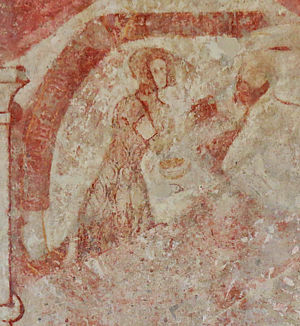
To the right of Visiting the Prisoner is Visiting the Sick (pictured right), in which a woman in a face-framing headdress and a heavily brocaded robe is shown attending to a sick man in bed. She is offering him something – it has been identified in the church leaflet as a custard tart – suitable food for an invalid’s jaded palate, maybe, but it might in fact be a bowl of porridge or some similar less delectable offering.
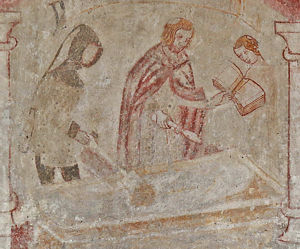
The final scene in the Cycle, and the clearest, is shown below. It is, appropriately, Burying the Dead. It is shown here in considerably enlarged detail because of its excellent state of preservation and its clarity.
A tonsured priest wearing a cloak is placed centrally, with an acolyte holding a book to his right. The priest is sprinkling with Holy Water a figure (almost completely gone now) in a coffin placed horizontally across the picture space. A man in a tunic and hood at the left assists at the burial – he is probably lowering the body in its winding-sheet into the tomb.
This is not a Requiem Mass, which would be sung solemnly in church, but the Office for the Dead, which might take place beside a bier within the church or at the graveside. Considered as one of the Works of Mercy, the social obligation aspect of the Burial of the Dead is interesting. Such was the importance of supplications for a dead person’s soul that many medieval wills include clauses providing specific sums of money for the poor on the day of the testator’s burial – for “buying victuals for the poor on the day of [his] burial and the eighth day after”.¹ Attendance at the burial, it went without saying, would mean helpful prayers for the dead soul in Purgatory. That this should be rewarded with food and drink must have seemed the merest social courtesy.
After this on the wall comes the scene, shown and discussed above, of Christ Blessing. He is surrounded by several speech-scrolls, and raising his hand in a gesture of blessing. Thus is the message of Matthew 25: 34-46 reinforced.
Click here for the Three Living and the Three Dead and St Christopher at Wickhampton.
Website for St Andrew, Wickhampton
¹ The will (proved 27 October 1430 at York), of William Byrley, butcher, of Attercliffe, Sheffield. (Abstract in A Catalogue of Ancient Charters, with abstracts of all Sheffield Wills proved at York prior to 1554, T. Walter Hall, Sheffield, 1913, p.32)